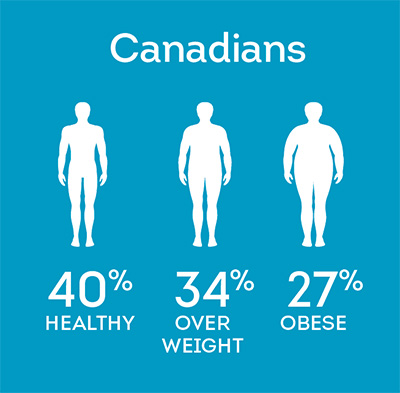Understanding Obesity

More than one-quarter of Canadians are obese
What is obesity?
 Obesity is a chronic disease that is characterized by excessive body fat, which in turn poses risks to an individual’s health.
Obesity is a chronic disease that is characterized by excessive body fat, which in turn poses risks to an individual’s health.
How do we determine if a person is overweight or obese? Health professionals use two measures to classify the weight of adults aged 18 to 65: body mass index, or BMI, and waist circumference, or WC.
BMI is based on height and weight. The formula is BMI = kg/m2 (weight in kilograms divided by height in metres squared). A BMI below 18.5 is considered underweight; 18.5 to 24.9 is healthy; 25 to 29.9 is overweight; and 30 or higher is obese.
WC is also a useful health indicator. Carrying excess fat in the waist and upper body (apple-shaped body) is linked to greater risk than carrying fat in the hips and thighs (pear-shaped body). A waist circumference higher than 40 inches (102 cm) for men and 35 inches (88 cm) for women is associated with a higher risk of developing certain chronic illnesses, including high blood pressure, coronary artery disease and type 2 diabetes.
Note that BMI and WC do not apply to children, pregnant or breastfeeding women, very lean adults, very muscular adults, adults who are not yet fully grown, and people over age 65, because the measures may under- or overestimate health risks for these individuals. (For example, certain athletes would have a high BMI, despite having low body fat, because they have a lot of muscle, which is heavier than fat.)
According to Statistics Canada, 40% of Canadians have a BMI in the healthy range, 34% are overweight and 27% are obese. Obesity has risen significantly in Canada over the past 25 to 30 years, and it is considered a public health epidemic.
What are the health risks of obesity?
Being overweight or obese raises an individual’s risk of health conditions such as heart disease, stroke, pre-diabetes, type 2 diabetes, high blood pressure, high cholesterol, some cancers, arthritis, gallbladder disease, sleep apnea and other breathing disorders, and many others.
The Canadian Association of Optometrists cautions that excess weight also increases the risk of certain eye conditions, including age-related macular degeneration, glaucoma, diabetic retinopathy and others.

What causes obesity?
We gain weight if we burn fewer calories than we consume; our bodies store the unused calories (energy) as fat. This sounds simple, but the risk factors that contribute to overweight and obesity are complex.
Certain factors are individual, while others are societal. Some are modifiable (meaning that we can influence them) and others are non-modifiable. Understanding your risk factors can help you prevent excess weight gain and its associated health risks.
- Lack of physical activity: Over time, we have become more sedentary at work and during leisure time. We also use more automated modes of transport instead of walking or cycling.
- Unhealthy diet: Research has linked low fruit and vegetable consumption with obesity. According to Statistics Canada, less than a third of Canadians eat five or more servings of
fruits and vegetables daily. Many of our calories come from foods that are low in nutrition and high in fat and sugar. We also eat out more than previous generations did, and restaurant portions tend to be large, encouraging overeating. - Genetics: Our genes influence how quickly we burn calories, our appetite and our body shape (where body fat accumulates). Obesity also runs in families, likely due to both genetics and lifestyle habits (diet, exercise).
- Age: As we get older and our physical activity decreases, we lose muscle mass and gain more fat. Body fat also tends to shift to the waist, which increases the risk of health problems. In Canada, 33% of adults aged 60 to 79 are considered obese, compared to 20% of people aged 18 to 39.
- Mental health: Stress, depression and lack of sleep can all contribute to overeating. Being overweight or obese can also contribute to poor mental health, including depression, shame, guilt and low self-esteem.
- Medications: Certain drugs can increase appetite or weight gain, including some medications for depression, seizures, diabetes or high blood pressure.
How is obesity treated?
 People who are obese may benefit from lifestyle changes, medication, weight-loss programs and surgical procedures. Working closely with a health professional can help individuals develop a personal plan and lose weight safely
People who are obese may benefit from lifestyle changes, medication, weight-loss programs and surgical procedures. Working closely with a health professional can help individuals develop a personal plan and lose weight safely
Lifestyle changes, such as doing more physical activity and eating a healthier diet, are often the first steps. Losing even 5% to 10% of body weight can reduce your risk for obesity-related health conditions.
Aim to exercise several times per week. The Canadian Society for Exercise Physiology recommends at least 150 minutes of moderate- to vigorous-intensity aerobic exercise per week. Start slowly, and be sure to consult your physician before starting a new exercise program.
Health Canada recently updated the Canada Food Guide (see “Resources,” below). The new guide emphasizes vegetables and fruits (fill half your plate), whole grains (one quarter of your plate) and a variety or protein foods (one quarter of your plate), not just meat and dairy products. The guide also recommends cooking at home more often, limiting foods that are high in salt, sugars and saturated fat, and being more mindful of our eating habits.
People often look for shortcuts to weight loss, such as skipping meals or trying a fad or crash diet that promises rapid results. These are unhealthy tactics, and they may even lead to greater weight gain in the long run. (For additional nutrition guidance, you may want to consider consulting a registered dietitian.) Changing life-long habits and patterns will take time; be patient and don’t dwell on setbacks.
Resources
Canada’s Food Guide
Obesity Canada
Canadian 24-Hour Movement Guidelines
Dietitians of Canada
